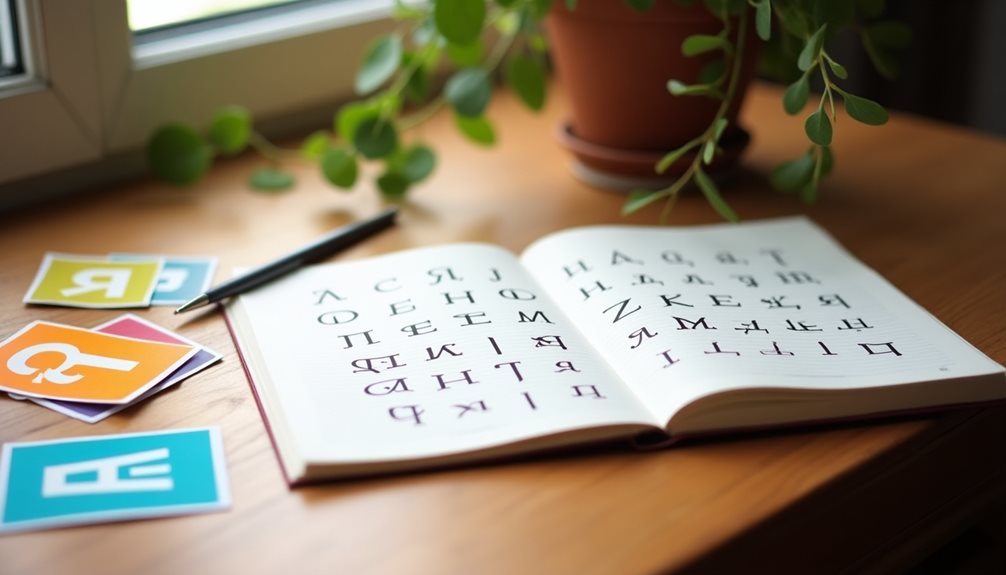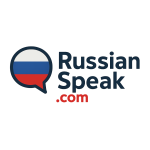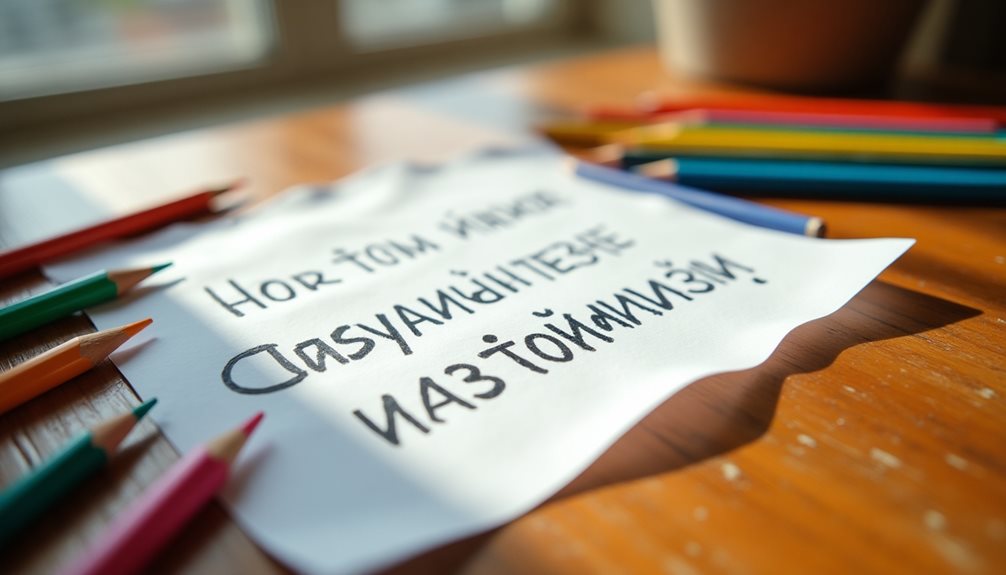Understanding how to write in Cyrillic script is essential for those beginning their journey into the Russian language. The Cyrillic alphabet consists of letters that represent distinct sounds, which are key for proper pronunciation. Beginners must also grasp the importance of stroke order and writing techniques to achieve fluidity. However, common pitfalls exist, such as confusing similar letters. Exploring effective practice methods can greatly aid in overcoming these challenges and mastering the script.
Table of Contents
ToggleUnderstanding the Cyrillic Alphabet

The Cyrillic alphabet stands as the cornerstone of written communication for Russian and numerous other Slavic languages, weaving together centuries of history and cultural evolution. Its origins reach back to the 9th century, when Saints Cyril and Methodius, determined to bring literacy and religious texts to the Slavic peoples, crafted the Glagolitic script. This early writing system laid the groundwork for what would become the Cyrillic alphabet, drawing inspiration from Greek characters and adapting them to capture the unique sounds of Slavic speech.
As the centuries passed, the Cyrillic script proved remarkably adaptable. It evolved along with the languages it served, giving rise to distinct variations tailored to regional dialects and national identities, such as those found in Serbian and Bulgarian. Each adaptation tells a story of local traditions and historical change, yet all share roots in a common script that binds diverse communities together.
Beyond its practical role, the Cyrillic alphabet carries deep cultural significance. It is a powerful symbol of Slavic identity and unity, a tool that has shaped literature, education, and international relations across vast territories. Through its letters, generations have found a means to express their ideas, preserve their histories, and affirm their place in the world. The continued use of Cyrillic not only connects people to their heritage but also fosters a sense of pride and belonging among millions.
The Sounds of Cyrillic Letters
The Cyrillic alphabet is the foundation of Russian writing and pronunciation. Each letter represents a unique sound, and understanding these sounds is essential for speaking and reading Russian accurately. Unlike English, where letters can have many sounds, most Cyrillic letters have more consistent pronunciations, though some still change depending on their position in a word or their neighboring letters.
One key aspect of Cyrillic is the distinction between vowels and consonants. For example, the letter А (pronounced “ah” like in “father”) is a vowel. It appears in many basic Russian words such as мама (ma-ma, meaning “mom”) and папа (pa-pa, meaning “dad”). In Russian, vowels can also indicate whether the preceding consonant is soft or hard—a feature not present in English.
Consonants in Cyrillic also have their own unique sounds. The letter Б (pronounced “b” as in “bat”) is a voiced consonant. You can find it in words like брат (brat, meaning “brother”) and банан (ba-nan, meaning “banana”). Russian consonants are grouped into voiced and voiceless pairs, which affects pronunciation but isn’t always obvious when reading.
Some Cyrillic letters can act as both vowels and consonants, depending on their placement. The letter Я (pronounced “ya” as in “yard”), for example, is a vowel but at the beginning of a word or after another vowel, it sounds like a combination of “y” + “a”. For instance:
- Яблоко (YA-bla-ka, meaning “apple”)
- Яма (YA-ma, meaning “pit” or “hole”)
Another interesting letter is Ч (pronounced “ch” as in “chop”). It’s always pronounced the same way, making it easier to learn than some English letters with multiple sounds. You’ll see it in words like:
- Чай (chay, meaning “tea”)
- Часы (cha-SY, meaning “clock” or “watch”)
A few important facts about Russian sounds:
- Russian has soft and hard versions of many consonants. The softness is usually indicated by special vowels (like Е, Ё, Ю, Я) or the soft sign (ь).
- Vowel reduction occurs in unstressed syllables. For example, А often sounds closer to “uh” when not stressed, as in молоко́ (ma-la-KO, meaning “milk”).
- There are letters in Cyrillic that do not exist in English, such as Ы (a sound similar to the English “i” in “bit,” but pronounced farther back in the mouth).
Learning these basic sounds and recognizing them in common Russian words helps learners build confidence. Mastery of Cyrillic pronunciation opens the door to clearer speaking and better understanding of spoken Russian.
A deeper understanding of these sounds enriches the learning experience, allowing individuals to communicate more freely and authentically in Russian.
Writing Basics: Stroke Order and Techniques
Learning to write Russian letters isn’t just about copying shapes—it’s about understanding the flow, rhythm, and structure that make up the Cyrillic script. For English speakers, this can feel like learning to draw new symbols. But with the right approach, it quickly becomes more natural.
Stroke order means the sequence in which you write the lines and curves of each letter. In Russian, as in English, a correct stroke order:
- Increases speed and confidence.
- Helps with neatness and readability.
- Builds muscle memory so writing becomes automatic.
For example, if you write the Russian letter “Д” (D) out of order, it may look odd or be difficult to connect to the next letter in cursive. This is similar to how writing an English “g” from the bottom up would feel strange.
Basic Stroke Techniques
Here’s what to focus on when learning Cyrillic strokes:
- Top to bottom, left to right: Most strokes begin at the top and move downward or from left to right, just like in English.
- One continuous motion: Aim for smooth, flowing movements—especially important for cursive writing (рукопи́сный шрифт / roo-kah-PEES-ny shreeft).
- Pressure and angle: Russian letters often have specific places where you should press harder or lighten your hand—this gives the letters their characteristic look.
- Connecting letters: In Russian cursive, most lowercase letters connect, which is different from English printing but similar to English cursive.
Advanced Concepts and Unique Perspectives
Cursive vs Print
In Russian schools, students learn cursive first (рукопи́сный шрифт), which looks very different from printed letters (печатный шрифт / pee-CHAT-ny shreeft). For English speakers, this is often surprising since print usually comes first in English education.
Letter Pairs That Look Deceptively Familiar
Some Russian letters look like Latin ones but sound different:
- Н н looks like English “H” but is pronounced “n.”
- Р р looks like “P” but sounds like “r.”
- В в looks like “B” but sounds like “v.”
Practicing correct stroke order helps reinforce their true pronunciation and meaning.
Developing Muscle Memory
Just as athletes practice drills, language learners benefit from repetition. Writing each letter slowly at first, then gradually increasing speed while keeping the form correct, will lead to automaticity.
Try this exercise:
Write “мама” (mama, meaning “mom”) five times in a row in cursive, focusing on connecting each letter smoothly.
Key Russian Terms for Writing Practice
- алфави́т (al-fah-VEET) – alphabet
- рукопи́сный (roo-kah-PEES-ny) – handwritten/cursive
- печа́тный (pee-CHAT-ny) – printed
- стрóка (stroh-KA) – line (of text)
- буква́ (BOO-kvah) – letter (of the alphabet)
- орфогра́фия (ahr-fah-GRAH-fee-yah) – orthography/spelling
Interesting Insights
- Many Russian children use lined notebooks with extra guiding lines to help them maintain correct height and slant of letters—a good idea for beginners!
- The discipline of careful stroke order carries over into clear thinking about words and language structure.
- Mastery of Cyrillic handwriting opens up personal notes, handwritten recipes, and even old letters—giving you direct access to Russian culture.
By concentrating on proper stroke order and practicing regularly, you’ll not only improve your handwriting but also gain deeper insight into Russian language and culture.
Avoiding Common Mistakes in Russian Handwriting
Learning to write in Russian can be challenging, especially for beginners who are used to the Latin alphabet. The Russian Cyrillic script has unique features, and there are several common mistakes that learners make. Understanding these pitfalls and how to avoid them will help you develop clearer, more confident handwriting and improve your overall Russian communication.
1. Neglecting Proper Letter Formation
One of the first hurdles is forming each letter correctly. Russian letters often look very similar, especially in cursive. For example, the letter “ш” (sh, pronounced like “sh” in “ship”) can be confused with “щ” (shch, pronounced like “sh” + “ch” together). If you neglect the details of each letter’s shape, your writing can quickly become hard to read—even for native speakers.
- Example: “мама” (ma-ma, meaning “mom”) could be misread if the “м” is not clearly formed.
- Important phrase: “Правильное написание” (pravil’noye napisaniye) means “correct writing.”
2. Confusing Similar-Looking Letters
Several Cyrillic letters either look alike or resemble Latin letters but represent different sounds. This is a major source of confusion.
- Б (B) vs В (V):
- Б (be, pronounced like “b” in “bat”) looks a little like a “6.”
- В (ve, pronounced like “v” in “vet”) closely resembles the English “B,” but it is pronounced as “v.”
- Н (N) vs И (I):
- Н (en, pronounced like “n”) looks like the English “H.”
- И (ee, pronounced like “ee” in “see”) looks like a backward N.
It’s helpful to practice these side by side and say their sounds aloud as you write them.
- Russian phrase: “Похожие буквы” (pokhozhie bukvy) means “similar letters.”
3. Ignoring Pronunciation and Spelling Connections
In Russian, there is a close relationship between how a word is pronounced and how it is spelled, but it’s not always one-to-one. Some letters are silent or change sounds depending on their position in a word.
- Example: The hard sign “ъ” (tvyordiy znak) never has a sound but changes how the previous letter is pronounced.
- The letter “е” can sound like “ye” or “yo,” depending on context.
If you ignore these rules, your spelling may not match your speech, leading to misunderstandings.
- Russian word: “Произношение” (proiznosheniye) means “pronunciation.”
4. Not Practicing Consistent Stroke Order
Proper stroke order is very important for writing Russian letters quickly and legibly. Each letter has a preferred way to be written—starting from the top or from the left, for example. If you don’t practice the correct order, your handwriting may become slow and messy.
- Russian phrase: “Порядок штрихов” (poryadok shtrikhov) means “stroke order.”
- Practicing with workbooks or tracing sheets can help build muscle memory.
5. Overlooking Spacing Between Letters and Words
Good spacing makes your writing easy to read. Beginners sometimes cram letters too close together or leave too much space between words. In Russian, just as in English, each word should have a small space after it, but letters within words should be close enough to show they belong together.
- Russian phrase: “Расстояние между словами” (rasstoyaniye mezhdu slovami) means “spacing between words.”
Key Tips for Avoiding Mistakes:
- Always write slowly at first, focusing on accuracy over speed.
- Compare your handwriting to printed or handwritten samples from native materials.
- Read aloud as you write to reinforce the connection between sound and spelling.
- Regularly review confusing letters and practice them in different words.
- Use lined paper to help with letter height and spacing.
Paying attention to these common mistakes will make your journey in learning Russian writing much smoother and more enjoyable. Accurate letter formation and good habits now will help you avoid confusion later on and make your written Russian clear to everyone who reads it.
Practice Exercises for Beginners
Having addressed common mistakes, beginners can now focus on effective practice exercises that build their writing skills in Russian. Handwriting exercises and character drills are essential components of mastering the Cyrillic script. These exercises not only enhance muscle memory but also improve overall penmanship.
| Handwriting Exercises | Character Drills |
|---|---|
| Write each letter 10 times | Write words with similar sounds |
| Copy simple sentences | Create flashcards for characters |
| Practice writing your name | Form sentences using new vocabulary |
Engaging in these activities daily will foster confidence and familiarity with the script. As learners progress, they will find that consistent practice leads to greater fluency and ease in written Russian.
Tips for Memorizing Cyrillic Characters

Many learners find the Cyrillic alphabet challenging at first, mainly because several letters look unfamiliar and some resemble Latin letters but represent different sounds. However, with the right strategies, memorizing these characters becomes much easier and even enjoyable.
A proven method is to create associations between each Cyrillic letter and something you already know. For example, the Russian letter “В” (pronounced “veh”) looks like the English “B” but is actually pronounced like the English “V” in “voice.” You could remember this by picturing a “B” saying “very” instead of “ball.” Similarly, “Р” (pronounced “ehr”) looks like the English “P,” but in Russian, it makes an “R” sound as in “row.” Building these mental links can prevent confusion and speed up learning.
Visual aids are incredibly helpful. Drawing simple pictures or doodles that incorporate the shape of each letter can make them more memorable. For example, the letter “Д” (pronounced “deh”) resembles an old-fashioned doorway—imagine someone saying “door” as you write it. For learners who are visually oriented, color-coding similar characters can also help keep them distinct.
Flashcards are a classic tool for memorization. On one side, write the Cyrillic character; on the other, write its pronunciation and an example word. For instance:
- Б (beh) – as in брат (“brat,” meaning “brother”)
- М (em) – as in мама (“mama,” meaning “mom”)
- С (es) – as in солнце (“solntse,” meaning “sun”)
Regularly reviewing these flashcards, both reading and writing them, reinforces your memory by repeated exposure.
Interactive online resources can make learning more engaging. Many websites and apps feature quizzes and games specifically designed to test your recognition of Cyrillic letters. Matching games where you pair Russian letters with their sounds or example words help reinforce what you’ve learned in a fun way.
Writing practice is essential. The act of physically forming each letter helps build muscle memory. Start by tracing over printed letters, then try writing them from memory. Practice forming not just isolated letters but also short words, such as дом (“dom,” meaning “house”) or кот (“kot,” meaning “cat”). This connects the visual recognition of letters to real usage.
Grouping similar-looking characters can also prevent confusion. For example:
- Ш (sha), Щ (shcha), and И (ee) all have vertical lines. Focus on their differences as you study.
- Letters like О, А, and Е look familiar to English speakers and often have similar sounds.
- Be careful with “false friends”—letters that look like Latin letters but have different sounds. For instance, Н (en) looks like “H” but is pronounced as “N.”
Learning a few basic Russian words and phrases can make the alphabet feel more practical and less abstract. Try:
- Привет (“privet”) – Hello
- Спасибо (“spasibo”) – Thank you
- Пожалуйста (“pozhaluysta”) – Please/You’re welcome
By connecting these strategies—associations, visual aids, flashcards, interactive tools, writing practice, and learning real words—you’ll find that memorizing Cyrillic characters becomes less of a chore and more of an interesting challenge.
Unlocking Russian: Your First Steps with Cyrillic
Learning to write in Cyrillic script is more than just mastering a new set of letters—it’s your gateway into Russian language, culture, and communication. As you’ve discovered, understanding the shapes, sounds, and stroke order of Russian letters builds a strong foundation for everything from reading simple words to writing personal notes and understanding street signs.
Building up your skills takes time and patience, but every bit of practice brings you closer to fluency. Start by focusing on the basics: proper letter formation, correct pronunciation, and consistent stroke order. Don’t rush—accuracy matters more than speed in the beginning. Use lined paper, make use of flashcards, and try associating tricky letters with images or English words to help them stick.
Remember, it’s normal to mix up similar-looking letters or stumble over new sounds at first. The key is regular practice—write out your name, copy simple words, and say the letters aloud as you write them. Embrace the mistakes as learning opportunities and review challenging characters often.
Most importantly, enjoy the process! Each letter you master opens up more of the Russian world to you, from classic literature to modern memes. With steady effort and the right strategies, you’ll soon find yourself not just recognizing Cyrillic, but using it with confidence and pride.
Keep practicing, stay curious, and let each new word bring you one step closer to real Russian communication. Удачи! (Good luck!)
Frequently Asked Questions
How Long Does It Take to Learn Cyrillic Script?
The time required to learn Cyrillic script varies greatly. Individual learning pace and personal motivation play essential roles, with some mastering it in weeks, while others may take months, depending on their dedication and practice frequency.
![]()
Can I Use Cyrillic for Other Languages?
Cyrillic can be used for several languages beyond Russian, including Bulgarian and Serbian. Many languages utilize Cyrillic adaptations, allowing for diverse phonetic representation, thereby enriching communication and promoting cultural expression among speakers of Cyrillic languages.
What Are Some Fun Ways to Practice Writing Cyrillic?
Exploring fun ways to practice writing Cyrillic includes engaging in writing games that enhance skills and incorporating calligraphy practice for artistic flair. These methods promote learning while allowing creative expression and enjoyment in the writing process.
Is Cursive Cyrillic Different From Printed Cyrillic?
Cursive Cyrillic exhibits notable cursive differences compared to printed styles. Letters often connect, altering shapes and forms, which can enhance fluidity in writing. Mastery of both styles is essential for effective communication and expression in the language.



